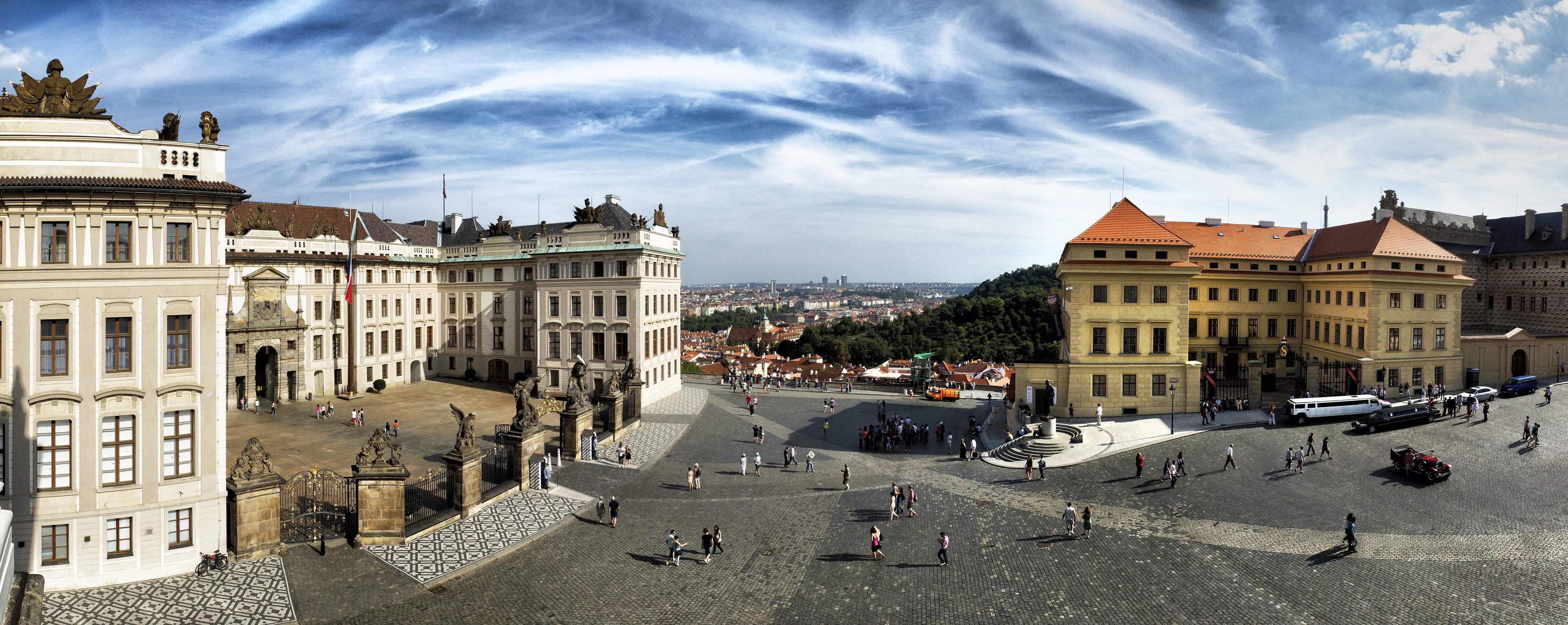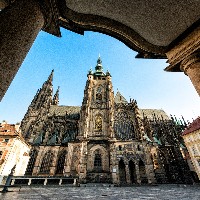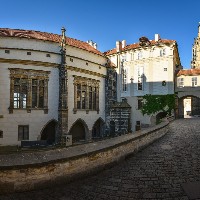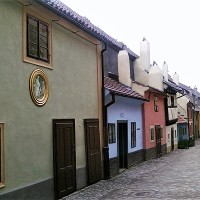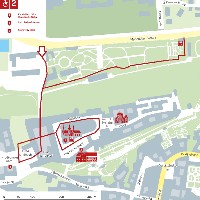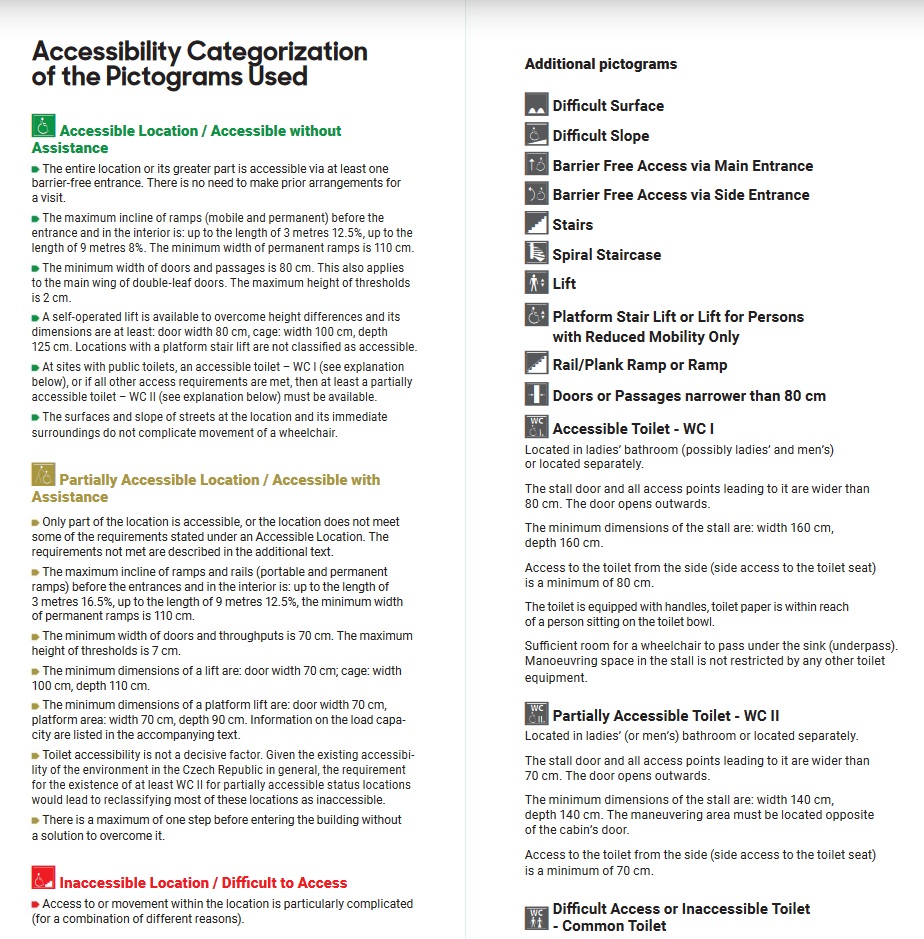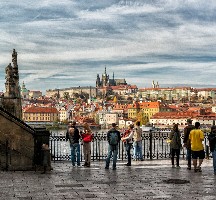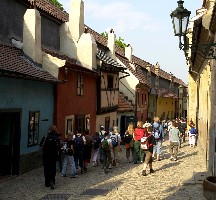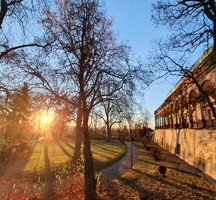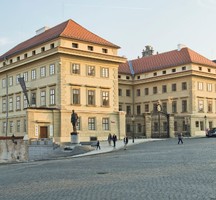Breadcrumbs navigation
Walk through the courtyards of the Prague Castle and the Royal Garden
Prague’s most famous landmarks on routes designed for people with limited mobility.
- Sports & Relaxation
- walking routes
Practical information
Difficulty Rating: Easy to Moderate
Route Length: 2 km
Download: Four Accessible Walks in Prague 1
ROUTE DESCRIPTION
The náměstí U sv. Jiří Square that connectss on its east side to the Third Courtyard of the Prague Castle, the Vikářská Lane, and the side entrance to the Royal Garden are all paved with very rough tiles with distinctive joints. Besides these short sections, the terrain is flat; the surfaces are mostly cobblestones, large-format paving tiles, or asphalt. The slopes of broad paths are generally mild and, except for a lowered curb on the sidewalk at the Powder Bridge, there are no steps or stairs on the route. You can handle the basic route unaccompanied, but we strongly recommend an escort for visiting the Golden Lane.
|→ Powder Bridge (Prašný most) → Second Courtyard of the Prague Castle →
The tour of the Castle District (Hradčany) can be started at the partially accessible tram stop “Pražský hrad” that is connected with U Prašného Mostu Street by a wheelchair modified crosswalk. U Prašného Mostu Street, paved with mosaic tiles and in a slight longitudinal slope, leads to the north gate of Prague Castle. Around approximately the second third, the pavement is interrupted by entrances to the surrounding buildings, so it is necessary to overcome low curbs (height 3 cm) and a rougher pavement.
Past the wide gate, at which the path sharply rises (10% slope) for about 5 meters, we reach the Second Castle Courtyard. The courtyard is surrounded by buildings comprising the so-called New Palace, whose interior is used largely for official functions. The entire complex received a unified exterior in the 18th century under Empress Maria Theresa, done in the Baroque-Classicist style. The centre of the courtyard is decorated with the Baroque Kohl’s fountain, originally a medieval well with a domed iron cage from the same period. The surface of the courtyard is paved with large format tiles.
→ Hradčany Square (Hradčanské náměstí) → First Courtyard of the Prague Castle Third Courtyard of the Prague Castle →
The imposing Matthias Gate, one of the earliest work of Baroque architecture in Bohemia, leads us the First Castle Courtyard, also known as cour d’honneur - a ceremonial entrance to the castle grounds. The area is again paved with large-format tiles.
The metal gate standing between two groups of wrestling titans, replicas of 18th century originals, leads us to Hradčany Square (Hradčanské náměstí). Here we fi nd a collection of magnifi cent buildings - the Renaissance Schwarzenberg and Martinic Palaces decorated with sgraffi to, the Baroque Toskánský and Archbishop’s Palaces, and the Salm/Salmovský Palace built in Empire style. A statue of the fi rst president of the Czechoslovak Republic T. G. Masaryk was placed here in 2000. The southern part of the square forms a terrace that offers a magnifi cent and unforgettable view of the whole city. The square area is paved with rough cobblestones and it slightly declines towards the main facade of the Prague Castle.
Due to the new security measures, we must return to the Prague Castle complex through the Fourth Castle Courtyard, around the Na Baště Garden. The modern Italian-Japanese garden design dates back to the fi rst half of the 20th century, and is the work of the Slovenian architect Josip Plečnik. The garden is located on an elevated terrace accessible only via a circular staircase.
Through the Second Castle Courtyard we reach the Third Castle Courtyard dominated by the magnifi cent structure of the Cathedral of St. Vitus, St. Wenceslas and St. Adalbert (katedrála sv. Víta, Václava a Vojtěcha). This Gothic cathedral, the spiritual symbol of the Czech state, dates all the way back to the 10th century, when Prince Wenceslas built a rotunda dedicated to Saint Vitus. The tomb of the saint and the patron of the Czech Lands, St. Wenceslas, became the central point of the building. The rotunda was then rebuilt into a more stately Romanesque basilica and during the rule
of Charles IV, it was redesigned into a Gothic cathedral according to the French design. The construction continued over the centuries up to the Neo-Gothic adaptations of the 1930s. To this day, the cathedral remains the largest and most important Catholic church in the Czech Republic.
The cathedral was founded in 1344, but its construction lasted almost 600 years. It was ultimately completed in 1929. The impressive interior features the St. Wenceslas Chapel with the grave of St. Wenceslas and the Crown Chamber, where the Czech crown jewels are stored.
While the cathedral follows the development of Church power, the Old Royal Palace (Starý královský palác), the Romanesque structure built in the style of an imperial Roman palace, demonstrates the development of secular power. Emperor Charles IV had the palace rebuilt in Gothic style with the adjacent All Saints Chapel. The palace was destroyed in a fire; its subsequent Renaissance form is preserved to this day. The large Vladislav Hall, used as a venue for coronation ceremonies and even knights’ tournaments, was built in late-Gothic style in the place of the king’s three Gothic halls. The kings from then occupied the newly built palaces of the current Second and Third Courtyards.
→ Náměstí U Sv. Jiří Square → Vikářská ulička → The Royal Garden (Královská zahrada) →x
The pathway between the Cathedral of Saints Vitus, Wenceslas and Adalbert and the Old Royal Palace leads to náměstí U Sv. Jiří Square. Once again, the square has several magnificent buildings. This section however, has a rough stone pavement. To go further up to the Golden Lane - accessed via a side street from Jiřská Street - expect not only a very rough surface of the road but also a pronounced slope (up to 15%).
From náměstí U Sv. Jiří Square we have an option to return through Vikářská Lane that leads north along the cathedral towards its front. The rough stone pavement continues here.
We will continue by going back to the Second Courtyard and from there to the Powder Bridge. Here, we can make a right turn and reach the Royal Garden. The main entrance gate is located approximately opposite the entrance to the Prague Castle Riding School and has +2 steps. The side entrance, located about 30 meters closer to the Castle is without elevation, but the surface behind it is paved with uneven tiles, and the terrain declines towards the garden (7% slope).
The Royal Garden was founded during the Renaissance era, which in turn defined the style of its unique period buildings - the Royal Summer Palace (Královský letohrádek) with the Singing Fountain (Zpívající fontána) and the Ball Game Hall (Míčovna). The villa of a former President Edvard Beneš was later added in the west part of the garden.
The garden greenery itself is also unique. It consists of centuries -old trees, chestnuts, maples, and other non-native species that have become naturalized since their original planting in our country.
The garden, in the shape of a long rectangle, is not uniform; it con-sists of several sections, while the parterres around each are loosely arranged. The whole garden slopes slightly from the west side, which translates into a minimal longitudinal slope of the walkways. They are mostly asphalt with occasional cracks. An exception is the area in front of the arcade of the belvedere, which is structured into regular flowerbeds with fine graveled paths in between them.
A short ramp paved with large tiles leads from the Summer Palace’s arcade into the garden (8% slope, width 123 cm, length 360 cm, no handles), which offsets four steps between the building and the garden.
The walk ends at the northeastern gate of the Royal Garden. A partially accessible tram stop with modified crosswalks is located in its close proximity.
The cathedral was founded in 1344, but its construction lasted almost 600 years. It was ultimately completed in 1929. The impressive interior features the St. Wenceslas Chapel with the grave of St. Wenceslas and the Crown Chamber, where the Czech crown jewels are stored.
Recommended Landmarks on the Route Cathedral of St. Vitus, St. Wenceslas and St. Adalbert (Katedrála sv. Víta, Václava a Vojtěcha)
Cathedral of St. Vitus, St. Wenceslas and St. Adalbert (Katedrála sv. Víta, Václava a Vojtěcha)
III. nádvoří Pražského hradu, Praha 1, www.katedralasvatehovita.cz

- access via the main entrance (single-leaf door width 120 cm), over two metal grate ramps (1st ramp: slope 16.5-1.5 %, width 250 cm, length 165 cm; 2nd ramp: slope 10.5 %, width 250 cm, length 105 cm)
- interior manoeuvring space is sufficient
- passages minimum width of 80 cm
- section of the floor at an incline (slope 10 %, width 250 cm, length 165 cm)
 Old Royal Palace (Starý královský palác)
Old Royal Palace (Starý královský palác)
III. nádvoří Pražského hradu, Praha 1, www.hrad.cz

- access via the side entrance (single-leaf doors 87 cm wide)
- access staircase (+7 steps) with a vertical platform lift (platform area: width 79 cm, depth 100 cm, load capacity 225 kg)
- interior manoeuvring space is sufficient
- passages minimum width of 80 cm
- access only to parts of the object
- interior doors thresholds height 2-10 cm
- partially accessible toilet in the front hallway (width 80 cm, width 197 cm, depth 217 cm)
 Salm Palace (Salmovský palác)
Salm Palace (Salmovský palác)
Hradčanské náměstí 1, Praha 1, www.ngprague.cz
Please note: The Salm Palace is temporarily closed in the first half of 2022!

- access via a joining hallway with the Schwarzenberg palace (double-leaf door width 2x120 cm)
- access to the palace entrance via a set of ramps (slope up to 10 %)
- access to the palace via a double-leaf door (width 2x 80 cm) with a ramp (slope 16%, width 192 cm, length 119 cm)
- interior manoeuvring space is sufficient
- passages minimum width of 70 cm
- a lift (automatically opening door width 80 cm; cage: width 109 cm, depth 137 cm) connecting the basement with up to the 2nd floor
- partially accessible toilet on the 1st floor (width 93 cm; stall: width 162 cm, depth 150 cm)
TOILETS
Public Toilet: Third Courtyard of the Prague Castle

- located in a separate building in the Third Courtyard, to the right of the entrance to the Cathedral of St Vitus, St Wenceslas and St Adalbert
- partially accessible toilet (door width 80 cm; cabin: width 172 cm, depth 172 cm)
- threshold (height 4 cm)
- space next to the toilet bowl is sufficient (width 90 cm)
- the toilet is equipped with two folding handles.
- baby changing station available
Detailed descriptions of the accessibility of the recommended and other properties on the route can be found at pragueaccessibilitymap.eu.
Contacts
- Walk through the courtyards of the Prague Castle and the Royal Garden
- Praha 1 – Hradčany
Information source: Prague City Tourism
